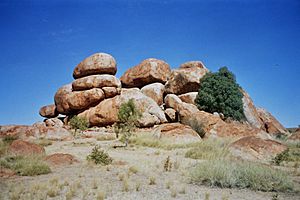Kaytetye people facts for kids

The Kaytetye (pronounced kay-ditch) are an Aboriginal Australian people. They live in the Northern Territory of Australia. Their traditional lands are mainly around Barrow Creek and Tennant Creek. They share borders with other Aboriginal groups. These include the Alyawarre to the east and the Warlpiri to the west. The main road, the Stuart Highway, runs right through their country.
Contents
The Kaytetye Language
The Kaytetye language is part of the Arandic group. This group belongs to the larger Pama-Nyungan family of languages. Unfortunately, the Kaytetye language is considered to be at risk. Some Kaytetye people also use a special sign language.
Traditional Kaytetye Lands
The traditional lands of the Kaytetye people were very large. They covered about 12,500 square miles (32,000 km²). These lands are located southeast of Tennant Creek. They included areas like Elkedra, the Frew River, and the Davenport and Murchison Ranges. Their northern boundary was near Kelly Well. The southern boundary was close to Mount Octy. To the west, their lands reached into the sandy desert. They also lived along Taylor and Barrow creeks.
Kaytetye Social System
The Kaytetye people have a special way of organizing their society. It is similar to the system used by the Anmatyerre people. They use an eight-subsection system. This system helps to show how people are related to each other. It also guides who can marry whom.
History with European Settlers
European explorers first entered Kaytetye country in the 1860s. This was when John Stuart explored the area. He was surveying for the Overland Telegraph Line. This line helped send messages across Australia.
The early interactions between the Kaytetye and Europeans were difficult. In 1874, there was a conflict at the Barrow Creek telegraph station. Kaytetye men attacked the station. This was in response to Europeans possibly disrespecting sacred sites or women. Two Europeans were killed. This led to a period of severe retaliation by settlers and police. Many Kaytetye people lost their lives during this time. Official reports were very low. However, unofficial accounts suggest many more people were affected.
After the 1890s, conflicts became less common. Later, in 1928, another serious event happened. This was known as the Coniston massacre. Police actions resulted in the deaths of many Kaytetye, Warlpiri, and Anmatyerre people. An inquiry later reported at least 31 deaths. However, Aboriginal oral histories suggest the number was much higher.
For many years, Kaytetye people worked with European settlers. They worked on cattle stations and in mining. But they were not treated fairly. This began to change during World War 2. An army settlement was built near Barrow Creek. Many Kaytetye men and women found fair employment there. This made it harder for pastoral stations to keep their Indigenous workers. This situation helped to improve how Kaytetye workers were treated. However, both mining and army jobs were temporary. This meant pastoral work was often the only option for Kaytetye people who wanted to stay on their traditional lands.
The Kaytetye call the area around Barrow Creek Thangkenharenge. This name includes a very important place called Elkerempelkere. This site is part of their creation story. The Kaytetye people continue to maintain their strong connection to these sacred sites.
The famous rock formations known as the Devils Marbles are also in Kaytetye country. The Kaytetye call them Karlu Karlu. This is a very sacred Dreaming site. In the past, some of its granite was removed. This was for a tomb for John Flynn, the 'Flying Doctor'. But after protests, the granite was returned.
Other Names for Kaytetye
- Gaididj
- Kadda-kie
- Kaitish
- Kaititj, Kaititja (This is how the Aranda pronounce it)
- Kaititje, Kaititj, Kaitidji, Kaitije, Kaitiji, Katitja, Katitch-a, Kattitch-a, Kat-tit-ya
See also
 In Spanish: Kaytetye para niños
In Spanish: Kaytetye para niños

